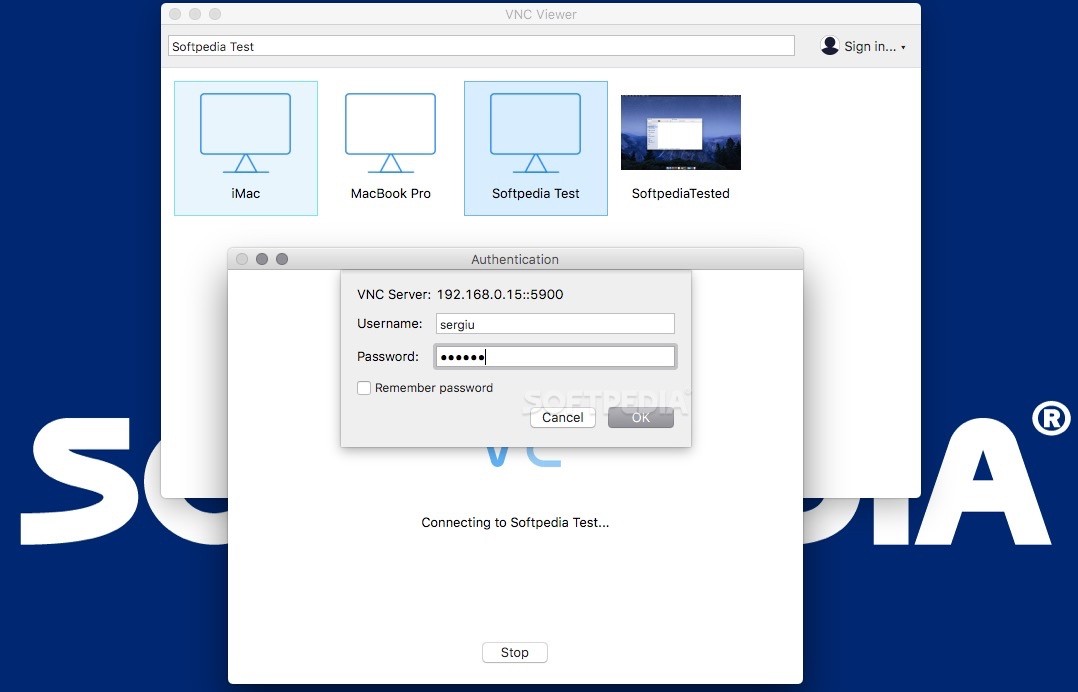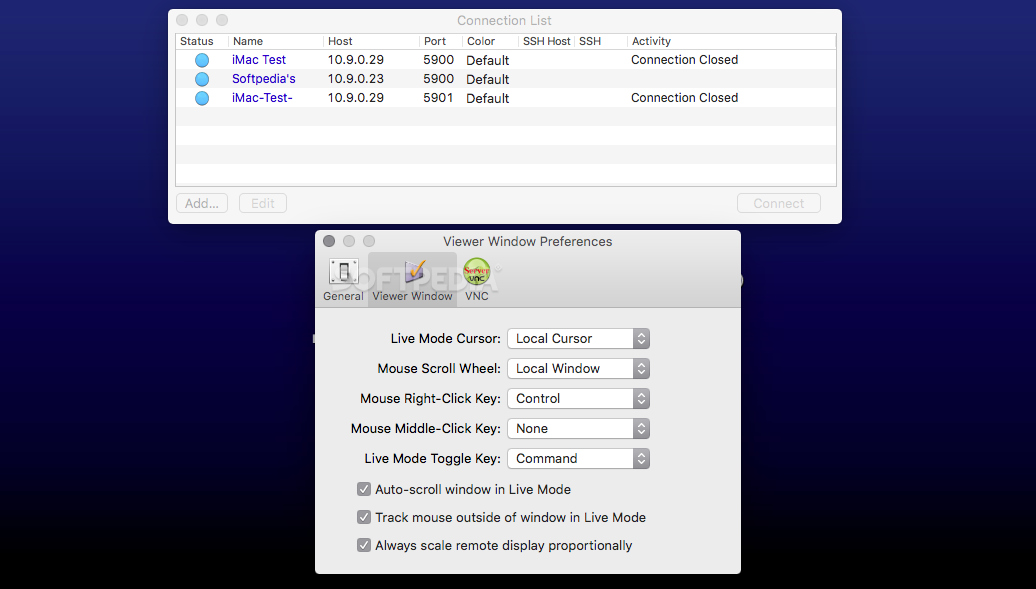Where Do I Begin?
VNC® Connect consists of VNC® Viewer and VNC® Server Download VNC® Viewer to the device you want to control from, below. Make sure you've installed VNC® Server on the computer you want to control. VNC, short for Virtual Network Computing, is a graphical desktop sharing system that relies on Remote Frame Buffer protocol to help users take control over another computer. Keyboard and mouse events are transmitted from one computer to another while the graphical screen is streamed back in the other direction over a network. VNC, the Remote Frame Buffer protocol (RFB) allows a desktop to be viewed and controlled remotely over the Internet. A VNC server must be run on the computer sharing the desktop, a VNC client must be run on the computer that will access the shared desktop. Legal Report Trademark Abuse VideoLAN, VLC, VLC media player and x264 are trademarks internationally registered by the VideoLAN non-profit organization. VideoLAN software is licensed under various open-source licenses: use and distribution are defined by each software license.
So you have a MacStadium hosted server and you're all ready to do something with it. The first question on your mind is probably 'How do I control this thing?'
Nearly all modern servers are 'headless' (meaning they have no dedicated monitor, keyboard or mouse) and are controlled over a network using remote desktop software. This article will cover four popular (and free!) remote control programs as well as the pros and cons of using each of them.
Vnc On Mac
VNC, Generally SpeakingMac OS X comes preinstalled with a remote control package called VNC (for Virtual Network Computing). In a just-out-of-the-box Mac Mini this feature is disabled, but since you need a way of connecting to your server to set it up, MacStadium has already enabled the screen sharing feature in the Sharing preferences panel which allows you to make a VNC connection from the get-go. All you will need are a VNC client, the IP address of the server and the password. The last two are supplied in an e-mail from MacStadium after you sign up.
VNC was originally developed for use on Unix systems but has now expanded to include a client and server version for virtually all popular computing platforms. This makes cross-platform remote control a simple matter, since a VNC client running on a PC can easily connect to a VNC server running on a Mac, for example. Of course, the devil is in the details and not all VNC implementations are 100% compatible. Mac to Mac sessions are probably going to be pretty reliable due to the same version of VNC code being used on both sides of the connection. PC or Linux to Mac connections have been known to occasionally exhibit buggy behavior but in most cases you will have no trouble getting it to work if your software is up to date.
Because it is based on an open-source project, VNC development was subject to 'forks' where different groups of programmers began with the same base code and then created different versions of the tool to suit their needs. This means that not only is VNC available on several different platforms, most platforms have more than one version with slightly different feature sets. Fortunately most of these features can be automatically negotiated during the connection process, so as a VNC user you usually do not care much which specific version of server you are connecting to - for the most part it Just Works. For this article I am going to discuss the two most popular VNC clients as well as two alternatives to VNC.

RealVNC
RealVNC is the closest thing we have to a standard VNC client due its long history and close association with the original code base. Today there are three versions of it, one that is free and two more that are for sale. Because I am discussing only free software in this article I am going to gloss over the Personal and Enterprise versions of RealVNC and focus on the Free edition, but it’s worth knowing that these other versions can be had for a nominal fee.
Where the paid versions of RealVNC are capable of encrypting the session data, this is the not the case with RealVNC free. That means that unless you take additional precautions, RealVNC free will transmit your keystrokes and screen images across the network in an unsecure manner, which could in theory expose them to a hacker. In practice (and especially when connecting to another computer on your own local network) this is not such a great danger, but where data must be transmitted over the public Internet and where security is a primary concern this sort of unencrypted communication should be avoided. All connections to MacStadium will have to traverse the Internet.
In my testing I used the latest RealVNC client available from the website (5.0.1 at the time of this writing) and I had no trouble connecting to the Mac on the first try. With older versions of RealVNC some people have had trouble establishing the connection (usually with a “connection refused” error) but most were able to get it working by clicking on Options and setting Colour Level to Full.

Video performance in VNC is pretty fast when connecting Mac to Mac, slightly less so when connecting from a PC. RealVNC is a good choice when you need a small, simple client just to make the initial connection to the server. For better security, performance and features there are plenty of other options that make this program seem a little outdated.
UltraVNC
Free Vnc Client Download
Project for mac free download. UltraVNC is a newer fork of the original VNC codebase that adds video compression to improve performance, a nifty graphical toolbar and an optional encryption module. It also seems to be a bit more stable than RealVNC. If you don’t already have the RealVNC client installed, this version is preferable to RealVNC just for these few additional features. Note that the encryption module will not work with the pre-installed OS X server though – you would need to install a different VNC server (such as Vine) on the Mac in order to take advantage of that feature. Check out the video below to compare the video performance of these two versions of VNC. The difference is small but noticeable. If you have to pick one or the other to download you might as well get the one that is slightly faster, right?
TeamViewer
Vnc Client For Mac Os
TeamViewer is commercial software that is free for personal use. The developer has thoughtfully included numerous nag screens to make sure you remember that commercial use is not allowed, but they still operate on the honor system and they make no attempt to verify the nature of your use.
The standout features of TeamViewer include automatic firewall traversal, a contact list, and built-in video chat, but the feature that really sets it apart from the rest of the programs in this lineup is the end-to-end encryption of every keystroke, screen image and mouse movement that goes across the network. If security is a primary concern then TeamViewer is definitely the best choice for you. Unfortunately the additional CPU overhead of encryption makes the video performance of this tool visibly worse than the others, as you can see in the video. For applications that require high frame rates such as playing video or games, this program is not going to be ideal.
Splashtop

This brings us to the final program that we will discuss, Splashtop. This program is newer than the others and it concentrates on bringing excellent video performance, the likes of which have never been seen in a remote control program before now. With a solid network connection you can reasonably expect to see videos playing on the remote desktop with frame rates comparable to videos playing on your local machine. That’s a pretty impressive trick at the moment.
Unfortunately there are a couple of downsides to this program. The first problem is a conspicuous lack of encryption, similar to my beef with the free VNC apps. The second problem is that the developer seems to be in the process of publishing a new version and has for some reason removed the old Windows client [edit - it's back now] from their own web site without adding a new one. The iPad client is there for download, no problem. Download hola unlimited free vpn for mac. The server side app, or as Splashtop calls it “The Streamer” is also available from their site, but the Windows client is nowhere to be found on splashtop.com (this may have changed by the time you read this). Not to worry though, dear reader, because we have located a link for the Windows client so you can download it right here.
Conclusion
To summarize, you will need a VNC client of some type to establish the initial connection to your Mac Mini, but once you are connected you can take the opportunity to install a server for any other remote control product that suits your taste. Our recommendation is to use UltraVNC initially and then install either TeamViewer (if security is you primary concern) or Splashtop (if performance is more important). Once this has been set up you will probably want to disable screen sharing (aka the VNC server) in the Mac system preferences so that no one is tempted to try to hack your VNC password.
I hope you are now feeling more familiar with your options for connecting to your MacStadium server. This is by no means an exhaustive list of remote control clients – there are tons more available of varying quality and weight and new remote control programs are being written all the time. It is probably worth trying a new one every once in a while to see if the state of the art has advanced since the last time you installed one, because these utilities are improving by leaps and bounds every day.
Download Vnc Client For Windows
If you have any questions about remote controlling your MacStadium server please feel free to leave them in the comments. Thanks for reading, and be sure to come back for more tips on how to get the most out of your hosted Mac!
